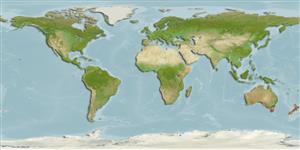Environment: milieu / climate zone / depth range / distribution range
Ecología
marino demersal; rango de profundidad 0 - 7 m (Ref. 84085). Temperate
Southwest Pacific: southeastern Tasmania, Australia and New Zealand.
Tamaño / Peso / Age
Maturity: Lm ? range ? - ? cm
Max length : 7.6 cm SL macho / no sexado; (Ref. 13227)
Short description
Claves de identificación | Morfología | Morfometría
Espinas dorsales (total) : 25 - 30; Radios blandos dorsales (total) : 14 - 16; Espinas anales: 2; Radios blandos anales: 25 - 27; Vértebra: 44 - 46. Snout profile steep, line drawn through tip of premaxilla across ventral margin of orbit touches or passes anterodorsal to dorsal extremity of preoperculum. Transverse groove in front of first
dorsal fin containing cephalic sensory pore. Scales absent in front of first dorsal fin first spine, naked immediately adjacent to first dorsal, but many small ctenoid scales adjacent to post-temporal. First lateral line scale with one group of ctenii at upper posterior edge, second scale onward, with two groups of ctenii at upper and middle posterior edges. Dorsal fin formula V-0N-0-1-0-1 (Ref. 84085).
Facultative air-breathing in the genus (Ref. 126274); Adults occur in rocky shores and occasionally in exposed rocky pools (Ref. 13227). Also common on wharf piles among encrusting invertebrates. Depth to at least 7 m (Ref. 84085).
Life cycle and mating behavior
Madurez | Reproducción | Puesta | Huevos | Fecundidad | Larva
Fricke, R., 1994. Tripterygiid fishes of Australia, New Zealand and the southwest Pacific Ocean (Teleostei). Theses Zool. 24:1-585. (Ref. 13227)
IUCN Red List Status (Ref. 130435: Version 2024-2)
Threat to humans
Harmless
Human uses
Pesquerías: sin interés
Herramientas
Special reports
Download XML
Fuentes de Internet
Estimates based on models
Preferred temperature (Ref.
123201): 13.5 - 16.3, mean 15.3 °C (based on 137 cells).
Phylogenetic diversity index (Ref.
82804): PD
50 = 0.5039 [Uniqueness, from 0.5 = low to 2.0 = high].
Bayesian length-weight: a=0.00617 (0.00288 - 0.01322), b=3.04 (2.86 - 3.22), in cm total length, based on LWR estimates for this (Sub)family-body shape (Ref.
93245).
Nivel trófico (Ref.
69278): 3.3 ±0.4 se; based on size and trophs of closest relatives
Resiliencia (Ref.
120179): Alto, población duplicada en un tiempo mínimo inferior a 15 meses (Preliminary K or Fecundity.).
Fishing Vulnerability (Ref.
59153): Low vulnerability (10 of 100).
Nutrients (Ref.
124155): Calcium = 209 [108, 585] mg/100g; Iron = 0.779 [0.388, 1.602] mg/100g; Protein = 18 [17, 19] %; Omega3 = 0.387 [0.157, 0.946] g/100g; Selenium = 9.32 [3.44, 24.44] μg/100g; VitaminA = 14.8 [3.1, 70.0] μg/100g; Zinc = 1.32 [0.79, 2.14] mg/100g (wet weight);
